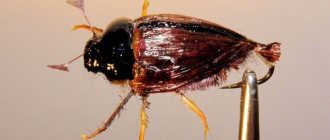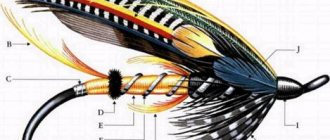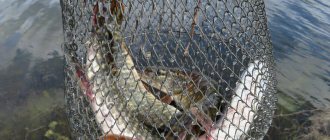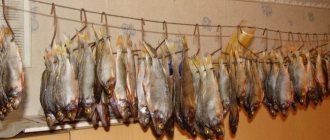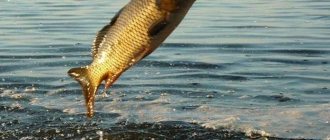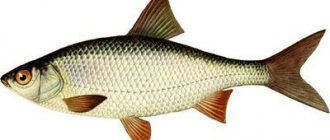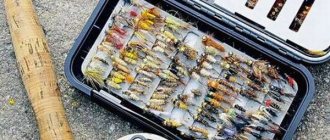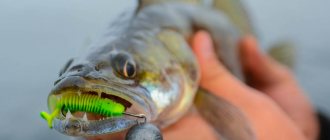Tackle for roach
Two types of tackle are used: a float rod and a fishing rod with a nod. Freezing of the hole will create inconvenience when fishing with a float. It is best to ship it so that it is submerged. This method is good for catching roach from the bottom.
At half-water, you should give preference to a fishing rod with a nod. There are certain requirements for winter gear. They must be very sensitive. The fish should respond with a nod to any approach. When fishing for roach, it is advisable not to make sudden fluctuations. The bait should move in the water more slowly than when catching predatory fish and rhythmically. Oscillation frequency is 60-80 per minute.
From the practice of fishermen it follows that the most optimal length of the nod will be up to 150 millimeters, and made of a steel plate. This nod can be used in still water and in quiet currents. To increase rigidity, simply bend the plate upward.
Various feeding methods are used. It's best to combine. Place one bait on the bottom, and open the other a meter from the bottom. You can pour it into the hole.
It, gradually getting wet, will sink to the bottom, covering a larger area, and attract fish. This method is applicable in reservoirs where there is no current that will carry the bait away from the fishing spot. A good result is obtained by using such a “decoy” as a front sight.
Cool time
An excellent time of day for catching roach is the morning, namely the period of dawn, when the fish actively moves through the reservoir in all its layers and especially the upper ones in search of food. Most often, roach can be found in reed thickets near the coastal zone, in shallow bays, and backwaters abundantly overgrown with underwater vegetation. Casting the bait is performed slightly to the side of the border of surface or underwater vegetation. Note that the roach does not stand in the reed thickets, it is located about half a meter from it, so the bait in the water will not go unnoticed.
Roach bites may occur during the day, but we note that the fish activity will be much weaker than in the evening and morning hours. During the day, especially in hot weather, roach should be looked for from the side of the shaded shore, where tree branches hang over the water. The fly is cast with the expectation that after it falls it will end up under a tree or a few centimeters from the branches. During the day you can continue to catch roach in this way, only if there is no wind at all; if there is a wave on the reservoir, then the roach moves into the thickness or falls to the bottom.
Roach is caught well with flies, so if after several casts there is no bite, this means that there are simply no fish in the selected area right now. When fly fishing, it is important to take into account the fact that the roach is constantly moving, so if after a series of casts there are no bites, you should move to another place and continue fishing.
Fly fishing for roach is a fun and interesting activity. If you follow certain rules, you are guaranteed to be able to catch some decent trophies.
What is a front sight?
This is a baitless, hairy bait. The method of fishing with a fly and a jig is identical, but at first glance. The front sight, unlike the jig, is lighter and more closely imitates an insect or its larva. It “plays” more smoothly in the water. Flies are divided into imitators and attractors. The purpose of attractors is to attract the attention and curiosity of the fish.
That's why they are also called fantasy flies. Their appearance is brighter. During production, luminescent materials can be used to form the tails, body, and legs of the bait. But the brighter the fly, the greater the likelihood that it will attract a predator. Therefore, for catching roach, it is better to choose flies that are not very bright, which resemble natural bait.
Fly for catching winter predator
Fishing for me has long ceased to be about catching fish. A favorite hobby has grown into a way of life. A deeper study of the habits of fish, its reactions to different colors, shapes, sizes and smells of baits has given rise to new unconventional approaches to fishing. This is how fly fishing flies appeared in my arsenal. What is the advantage of these sophisticated baits and are they really better for catching fish?
Perch
I have always caught perch using a balance beam and a reelless bait. With a balancer, be sure to use a hanging tee with a bright drop or cambric. But at the same time, there were often idle bites, disappearances, or the fish did not bite at all, although it was felt that there was one under the hole. On one of these fishing trips, I remembered that perch, especially passive ones, do not attack, but, approaching the bait, try to pull it into the mouth using the movements of the gill covers. The light bait easily flies into the mouth of the fish, and the angler feels the bite. If the bait is heavy, then the predator is not able to retract it and quickly loses interest in it. Often, only the hanging tee gets into the fish's mouth.
To increase the chances of a confident bite and catching a fish, I tried tying a fly on a single hook and hanging it from a balancer on a fluorocarbon leash 3-5 cm long.
DIY winter flies for perch, fishing techniques and equipment
Oddly enough, winter flies for perch are not yet very actively used in ice fishing for striped fish. Practical experience proves that the use of these artificial baits increases catches. When the average amateur fisherman hears the word “fly,” he associates it with something complex from the field of fly fishing. Let's look at how to effectively and easily use perch flies for winter fishing. The banal suspension of an additional hook with red hairs next to a heavy bait (jigs or spinners) as a provocateur increases the catchability of the equipment. For winter perch, you don’t need to look for special, expensive fly fishing flies. Decoys can be easily and quickly made on your knees from scrap materials.
Do it yourself
To make flies you should use the following tools:
- scissors;
- vice or clamps;
- feather holder;
- needles;
- threads;
- spool holder;
- tweezers;
- brush;
- lapma;
- magnifying glass or magnifying glass;
- mirror;
- mortar.
The most commonly used materials for making flies:
- hooks (especially for flies, they are thinner than regular ones);
- feathers (from rooster, goose or duck);
- wool;
- Lurex;
- glue;
- thread for installation (it is better to use silk);
- dabbing.
Most often, flies depict the following insects:
The general principle of making flies looks like this:
- Remove the hook from the spoon and pull a few hairs through the ring.
- Using a cambric, secure the hairs in this position.
- Place the cambric on the hook ring.
- Using a needle, fluff the hairs so that they become more voluminous.
Fishing technique
Artificial flies in winter perch rigs are needed to provoke the striped fish to bite. Often attracted by the vibrations of the balancer, the predator stands near the bait, looks at it, but does not take it. This behavior is more typical for passive perch. But if there is a light fly in the rig, then when playing with the bait, two objects already move in the water, a large and a small one. This turns on the predator’s food competition reflex, and the fish attacks the small bait (so that the prey does not “get” the large one). When using flies, the number of bites increases significantly. And the perch takes just a fly, and not a balance beam or a spinner.
Flies for perch in winter do not require a special design. At a minimum, it's just a couple of red fluffs on the hook. The main thing is to create a provocateur, a point of attack. Sometimes even just a piece of red foam rubber or silicone works.
Fly fishing
On hot days, bushes hanging over the water are a real feeding point for a flock of chubs. A voracious roach will also not swim past a fat caterpillar that has fallen from a bush (photo 3) or a grasshopper that has jumped past a blade of grass (photo 4). In a forest stream, dace is caught using an ant imitation five, but if there are roaches there, then there will be no special problems with the selection of bait (photo 5).
To catch roach with a nymph, you need some special gear: a 5-6 class carbon fiber rod with a length of 2.4-2.7 m is suitable. The “sooner” its action is, the better, because you will have to not lift a weightless dry fly from the surface on hook No. 22, and pull out a nymph loaded with lead from a depth of several meters on hook No. 8-10.
Homemade flies
Ready-made flies for winter fishing for perch are sold in stores. Whatever you like - imitating bloodworms, jigs, amphipods. Beautiful and expensive. But there is no need to buy such expensive products. To catch other fish with flies - yes, you need to bother. The catchability also depends on the fly itself. When hunting perch in winter, this factor is completely secondary. What is more important is the presence of the provocateur and its correct placement in the equipment.
It’s very easy to make winter flies for perch with your own hands. To do this, threads, feathers, and fibers are attached to the hook. They are attached to the forend by tightly wound thread, and waterproof varnish or glue is applied on top. Beads, beads or cambrics are attached to the hook. If you wrap the fore-end with thicker shiny lurex (or make a body out of glue or varnish) you will get a whitebait front sight. This is a very effective bait for perch in winter. Lately, flies have been gaining popularity - a logical development of fry flies made of silicone or plastic with a tail made of lint. Making flies is an interesting process in itself. It brings special joy when a bait made with one’s own hands brings bites.
The fly is light, when the rig is dropped, it sinks slowly, the fibers and tails naturally move, attracting a predator. You need to experiment with color. On some bodies of water, bright colors work better - red, yellow. In other conditions, dark colors will work - black, brown, green, olive.
Sources:
https://34fish.ru/lovlya-plotvy/lovlya-plotvy-zimoi-na-mushku https://rybalke.net/mushka-dlya-lovli-zimnego-hishhnika https://podlednik.ru/lovlya_zimoj/khishhniki/ zimnie-mushki-na-okunya
Fly fishing in winter and dabbing for tying flies
Traditional methods of winter fishing for perch and roach from ice are mainly limited to spoons, float rods and jigs. There are still attempts to instill angler fishing with balance beams, but so far the theoretical promises are poorly consistent with practical results.
The “goat” has a much better chance of becoming 3rd in performance after the traditional jig and spinner. Although opinions here can and should be different, first of all, because different bodies of water like different baits.
With the jig, everything is more or less clear, at least, so much has been written about it that it’s unlikely that anything new can be invented. In this respect, a spinner is not much different from a jig. Everything has been discussed, but it is interesting that the results are unpredictable and often incomprehensible and absurd.
You can blame it all on the incalculable combination of shapes, weight and quality of play of this bait. How should you fish in order to say: “My lure is better and I pull more correctly”? I think that it is unlikely that at least one sane fisherman would dare to say so. You can test the perch’s appetite with a “goat”. It plays the same for almost everyone and looks the same without much change for many decades.
Therefore, if there are problems with biting, then they are there, below, and not in the fisherman’s head. Although here you can take a step to the side. Particularly gifted people decorate lead pigs with wires and place cambrics and beads on dangling hooks. We can agree that this may attract curious fish.
But, in my opinion, it’s more important to know the body of water where you fish for a “goat”, then you’ll catch it. But there are places where it doesn’t take it, but with a spoon with a jig – no problem. Those who fish with goats attribute failures on some lakes to their loose peat bottom. That is, the reason was found to be purely physical, a piece of lead is sinking in the ground.
I haven't caught much with this tackle. This is probably why I am skeptical about the “goat”; I consider such fishing too monotonous. Although, without a doubt, I was very surprised by the catchability of this bait on lakes with a sandy bottom, where there was a dominance of small perch. I don’t really understand the reason why the perch is so energetically interested in this “goat”.
I can reason along an already beaten path. Gray lead measuring 1-2 cm imitates something living, or provokes fish with its movement. Adding beads and cambrics can also cause the fish to become more interested and aggressive.
But as a fly lover, in these moments of someone else’s success, the continuous biting of the “goat”, I was frankly pleased by the fact that about a third of the fish pulled out were stained on the outside, that is, the fish often did not grab the bait, but were simply curious “what kind of crowd is this?” “Are you ready?” and got hit on the chin.
The second acted like oil for the soul - half, or even more, of the fish were caught on a fly suspended above. Among the fishermen I know, no one goes out on the ice with a naked “goat”.
And especially practical fishermen have been hanging a fly on their lure for a long time. Most often this is a regular hook with bright lurex, foil or wire and a red tail. There are a lot of options for such flies. What they all have in common is ease of manufacture; you just need a good, high-quality hook, since the fish often hook themselves.
Such a simple fly for winter fishing does not really look like something living, well, maybe like a bloodworm, if you take into account the shape and color, and it works by irritating the fish with contrasting color and movement.
See also: How to find a catchable place?
Amphipod fly for winter fishing for roach and perch
But this, sometimes, is not enough for a bold bite from cunning and suspicious perch and roach. It’s not for nothing that amphipods, or rather amphipods, have become so popular in recent years. Perhaps, in winter, only this fly has a chance of copying a living organism in appearance and movements. But there are several important questions here too.
First: is this same amphipod present in our reservoir? In silted and peat lakes it is found very rarely, usually it is not there at all. If the fish is not familiar with the amphipod, then its attractiveness is significantly reduced, then it is easier to fish with a jig with a bloodworm.
Second: you need to guess with color and size. The natural colors of amphipods are grayish-olive, dark green; this depends, as many argue, on the prevailing tones of the bottom soil itself. But it has been noticed that the unnatural, attention-grabbing orange shades of the fly simply act magically on active perch, including large ones. If a company is fishing or the lake has already been explored, then you can select the right fly quite quickly.
Another thing is how to catch amphipods, what kind of game is needed? Here the situation with the spinner is repeated, you need to try this way and that, and one of the options will turn out to be optimal. And you need to take into account the depth, the weight of the fly, the thickness of the leaders, and the size of the fish. Taken separately, these factors are not difficult; you need to create the right combination for a specific case.
I’ll try to tell you how to make a fly yourself from scrap materials. I will mention the best, classic options and suitable materials.
There are 3 main points in the process of tying a fly.
1. Weight the hook by wrapping it with lead wire or strips of lead.
2. Wind a shaggy thread that imitates the body and legs.
3. Cover the top of the body with a backrest or strips of translucent film.
Amphipods 1-1.5 cm long usually predominate, that is, a standard 10-12-14 fishing hook will do. Considering that the amphipod can be humpbacked, and the forend can be bent into an arc using pliers, or even better, take specially shaped curved hooks Kamasan B240, B100 or Maruto hooks c46, c46FW, c16 or c29.
Although a scrupulous and observant angler may notice that the crustacean in the water is often flat. Maybe it depends on the type of crustacean or its condition, so there won’t be a big mistake if you use hooks with a straight shank for tying. It is better to take lead wire for winding the body with a diameter of 0.5-0.7 mm.
Thin wires 0.2-0.3 mm are more convenient to wind, but they are not very economical, especially on hooks No. 8-10. You can increase the hump of the fly by attaching one or two strips of lead. Then the asymmetrical load will increase the lateral movements of the bait. In theory, the crustacean is flat by nature, and fans of classic things use pliers to squeeze the lead body on both sides.
Dabbings for tying flies
The selection of fluffy material for the bait body largely depends on your own capabilities and preferences. This can be regular wool combed from a suitable rug, socks, grandma's scarf, or commercial fly tying material. The main thing is that after winding, individual fibers stick out to the sides by 2-2.5 mm, and the body looks fluffy.
There are animal hair materials and synthetic fibers specifically designed for this purpose. For example, there are ready-made shaggy dubbings (twisted threads or thin wires with pinched, protruding fibers) made of mohair or other wool, with the addition of synthetics, feathers and other funny things.
See also: How to fish with spoons?+Video
But most often we are dealing with just a bunch of fibers, it’s cheaper, but you have to twist it into dubbing yourself. In principle, it is not difficult. We divide the leading thread in two and evenly push the wool into the gap between the threads, 3-4 cm long. To make the fibers stick better and not fly apart, the thread can be lubricated with glue.
Now with two fingers we twist both parts of the thread into one, the thread twists and pinches the wool, resulting in such a shaggy strand. We wrap it over the lead, forming the body of the crustacean. In addition to the color of the body material, you can pay attention to its other qualities. For example, dubbing fibers with the names Sowscud, Antron and Antron Bright are used to make soft legs that shimmer in different colors and sparkle in the water.
Possum wool dubbings - Possum have coarser fluffy fibers and are good for large, heavy crustaceans, while synthetic Kaufmann and Crawdub also shine in the light. The most versatile and simple material is rabbit fur, you can pluck it from a hat or buy it in a store.
It produces soft legs that play well in the water. But the legs are obtained when we cover the body with a strip of film on top, forming the back of the crustacean. Ideally, the strip should cover the back and a little of the sides; the remaining fibers stick out down and form the legs of the amphipod. The quality of the back is important.
I would like to have a suitable film that matches the color of the body material, preferably transparent enough so that the air bubbles stuck inside and the interweaving of threads are visible. When choosing it, you need to take into account that some materials look different in water than in air and vice versa.
Previously, strips of surgical gloves were cut from latex; sausage skins (natural intestine) were popular. The translucent skin of smoked horse mackerel and the like worked best. If you don’t want to bother, stores sell special durable, translucent and elastic Scud Back strips or dyed raffia, a grass that absorbs water and transmits light.
The final stage of tying is wrapping the back and body, creating a visible effect of dividing the body of the fly. This process is simple, but very important. Often the bent characteristic appearance and well-defined body joints play the main role in the bite, everything else is secondary.
Classic amphipods have a winding made of 0.10-0.18 mm fishing line, although it is easier to make it from copper wire. The winding often crushes protruding fibers that imitate legs. Therefore, after the head is formed, the ready-made fly needs to comb the abdomen with a needle, freeing the pressed hairs. The fly can be tied with a tail sticking out from behind or glued eyes.
I will mention approximate color combinations of the back, torso - legs and the winding itself:
1. transparent, olive, copper wire
2. transparent, olive with grayish fishing line
3. transparent, pinkish brown, silver wire
4. natural yellow, yellow, gold
5. brown, taupe, copper wire
6. light brown, light olive, copper wire
7. bronze, light orange, gold
Usually, in the boxes of understanding people, flies with a combination of warm colors with warm colors or cold colors with cold ones predominate.
It is difficult to say which of these is the best. Much depends on the depth, transparency, illumination and color of the water. You can start fishing with colors that are close to natural; if you don’t catch them, then move on to increasingly brighter and more aggressive ones. Or vice versa. This concerns the size of the fly and the activity of playing with it.
If you are lucky on the ice, do not forget that such amphipods are needed not only in winter, but also in early spring. They can be used to catch roach, silver bream, ide, chub, barbel in open water using a fishing line with a float, and to cast perch from a boat in a plumb line. It can be called a universal bait.
Source
